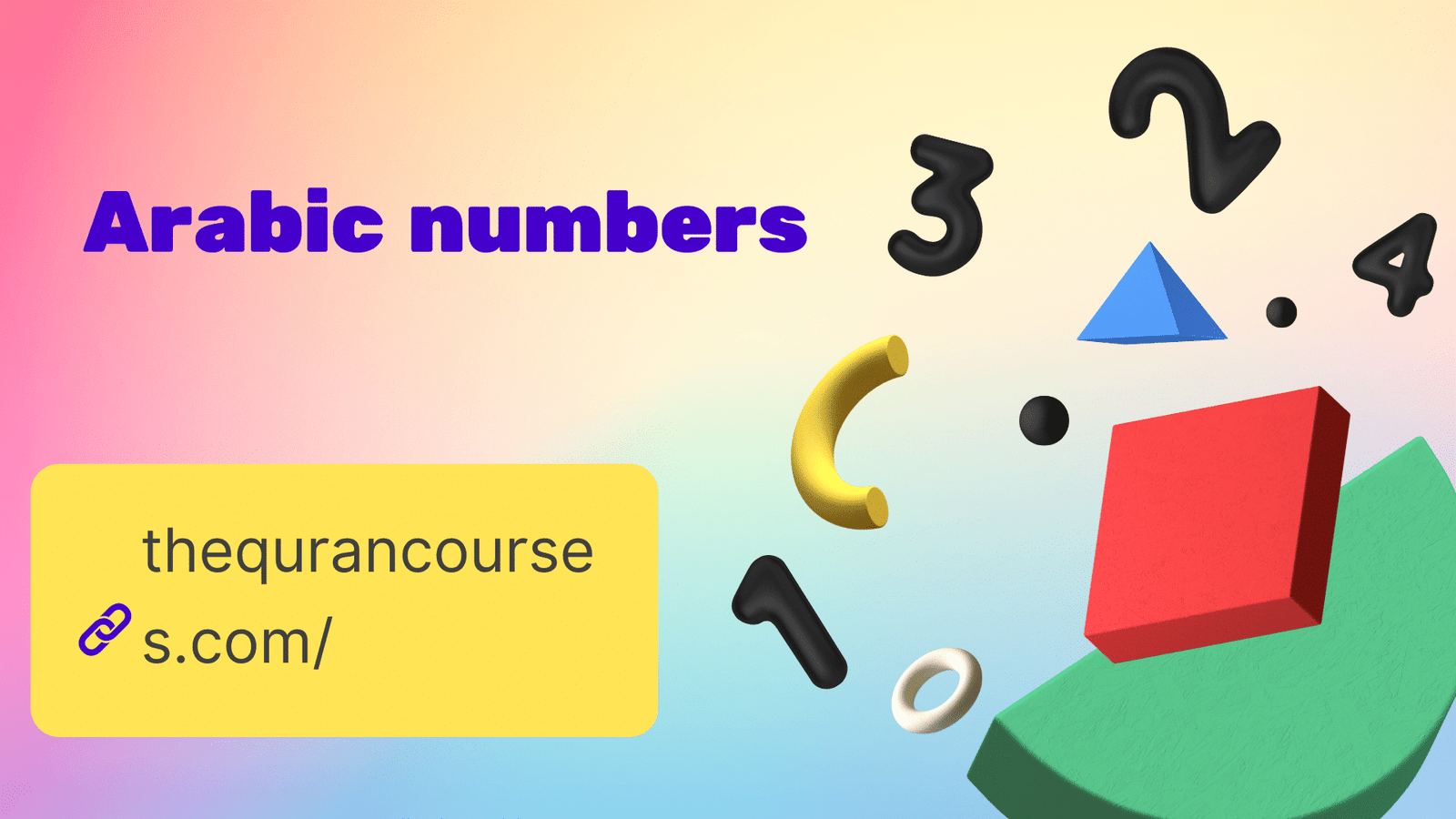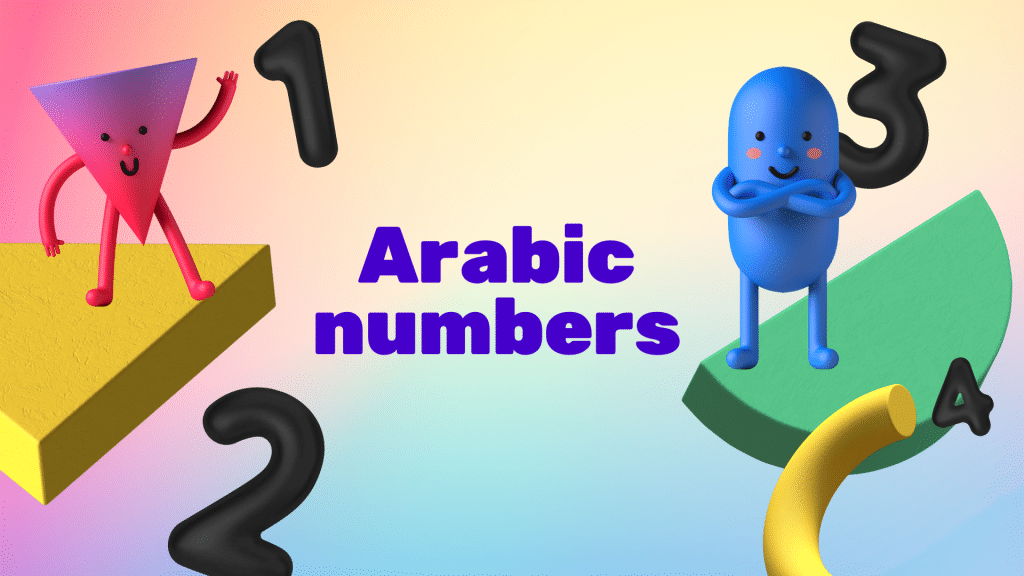Arabic numbers are possibly one of the most challenging concepts for Arabic students to grasp. Although learning Arabic numerals might be complex, they are critical to language comprehension! So we are here to help you to understand it
Arabic Numbers
You may be surprised to realize that you already know many Arabic numerals, despite learning a new set of Arabic numbers.
The (0, 1, 2, 3, 4, 5, 6, 7, 8, 9) numbering system, adopted by Europe and the Western world in the 12th century AD, is essentially Arabic.
It is derived from the Hindu-Arabic number system, divided into three families.
The Hindu numerals, which are used in India, are the first family.
The second family of Arabic numbers, known as West Arabic numerals, was adopted by the western world and is now widely used in international trade.
What Is the Meaning of Arabic Numerals?
Arabic numbers are probably definitely familiar to you.
Because the numerals we employ are derived from the Arabic language, we mention it frequently in English even if we use Roman numerals.
Are our numerals, however, identical to those in Arabic? It would imply that there isn’t much to learn…
Intriguingly, Arabic speakers and Muslims refer to Hindi numbers, even though they originated in India.
In the 9th century, the Arabs took Indian numbers to create what we now know as Arabic numerals.
In North Africa, these numbers underwent multiple transformations before becoming the Arabic numerals we know today. They still have substantial similarities to their Indian cousins.
Let’s know more about these numbers.
What Arabic numerals are these?
We name our numbers Arabic numbers in the United States.
That’s how they’re known all over the world.
Even in China, Arabic numerals (instead of Chinese digits) are referred to as “Arabic numbers.”
The only possible exception is in areas where Arabic is spoken.
It turns out that the “Arabic numbers” that English people are familiar with are Western Arabic digits.
These are known as “Hindu-Arabic numbers” or nim al-ad al-hind al-Arab (nim al-ad al-hind al-Arab) in Arabic.
What are Arabic numbers exactly?
Eastern Arabic numbers are still widely employed in Arabic writing; therefore, we’ll concentrate on them today.
It’s crucial to remember (and possibly reassuring) that Western Arabic numerals are generally recognized.
They’ve superseded Eastern Arabic in numerous public displays such as street signs and advertising.
Let’s look at these numbers, review the Arabic number forms, and begin applying them in Modern Standard Arabic to grasp better how to count numbers in Arabic.
Why is learning Arabic numbers useful?

Because Arabic is usually regarded as one of the most challenging languages to learn, it’s critical to use all the resources available to you.
Nothing can help you learn Arabic more than living in one of the numerous Arabic-speaking nations, but you’ll need to learn how to count from one to several million to do so.
Knowing Arabic numerals will come in handy in a variety of situations:
- Work
- Negotiations
- Arithmetic and math
- science
- Purchasing and paying for items
- Age
- Height
- Weight
- Time
- Months and days
- Year of birth
- Sports
- Distances
As well as for your Arabic classes, of course.
Learning Arabic numbers will assist you in various things in your everyday life.
They’ll let you hold your own in discussion with a native speaker without having to continually consult your Arabic dictionary to figure out what they’re saying and respond.
It’s hard to avoid learning the numbers and counting in a new language while learning a new language.
Consider your preschool years, when you first learned to count before learning to read. For Arabic, it’s the same thing!
Learning to count is essential for managing everyday life in any Arabic-speaking nation and surviving an immersion program.
When reading Arabic numbers, which way do you read them?
As you may know, French, Spanish, English, German, and many more languages are read from left to right.
As Arabic students learn Arabic and the Arabic script, this is frequently one of the first stumbling obstacles they face.
This is because the Arabic language has about 300 million native speakers (420 million if you add all the people who speak it as a second language, and one billion if you include all the Muslims who consider it a sacred language) written from right to left.
In contrast to many other Indo-European languages, they usually read from left to right and are dextroverse.
Arabic is a Semitic language with sinistro (from the Latin meaning left) verse.
Hieroglyphics, Cuneiform letters, and Oscan (the first known language) are all written from right to left.
Arabic is a descendant of Aramaic, written from right to left.
One of the reasons Arabic is still read from right to left is because of this historical legacy.
The fact that Arabic numbers are written from left to right is perplexing.
The greatest numerals in Arabic are on the left, while the lowest numbers are on the right.
However, the direction in which you read does not alter. You start with the most diminutive figure when reading or saying a number.
So, whereas 247 in English means “two hundred and forty-seven,” in Arabic, it means “seven, forty, two hundred.”
In Arabic, telephone numbers are an exception. Therefore, they are read they outnumber by number, from left to right, just like in English.
Arabic numbers are an example of global citizenship
You may become an ambassador for your native nation by learning Arabic.
When you study Arabic, you get essential language abilities.
It is simpler to learn French or Spanish than to learn English.
Furthermore, learning these languages will enable you to travel or work in various places, particularly in Europe.
However, because of more learners and speakers of these languages, you will face more competition.
If you study Arabic, you can be sure that there will be a high demand for your language abilities because supply is limited.
Furthermore, learning Mandarin Chinese, for example, will restrict your employment options to only a few nations.
If you study Arabic, though, you will have more chances because the language is spoken in 58 nations.
Read More: The number of the children of Aadam




